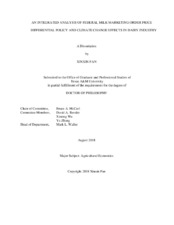| dc.contributor.advisor | McCarl, Bruce A. | |
| dc.creator | Fan, Xinxin | |
| dc.date.accessioned | 2019-01-18T15:09:36Z | |
| dc.date.available | 2020-08-01T06:37:38Z | |
| dc.date.created | 2018-08 | |
| dc.date.issued | 2018-08-03 | |
| dc.date.submitted | August 2018 | |
| dc.identifier.uri | https://hdl.handle.net/1969.1/174011 | |
| dc.description.abstract | This dissertation investigates the match of current Federal Milk Marketing Order (FMMO) price differential policy with current conditions and the effects of shifting diesel prices on price differentials along with climate effects on milk production. A spatial mathematical model (MilkOrdIII) of the dairy industry is modified to include milk components and organic milk then used to study milk pricing, and the effects of changing diesel prices. Subsequently, climate impacts are explored using spatial econometric panel modeling.
This work is reported from three aspects. Firstly, it addresses how the present Class I price differentials under FMMOs compare to an model-generated idealized set. It also does a comparison for Class II, III, and IV milk and constructs price surfaces for organic milk, and milk components. The results show that the current Class I price differentials are not a good reflection of ideal differentials under today's conditions. We find the price differential pattern is similar to that of today's policy but the range of values is substantially wider. Thus updating may be desirable. For organic, Class II and IV milk and butterfat may merit regionally differentiated prices. Class III and the other milk components appear to be handled with a uniform price.
Secondly, this research examines the diesel price influences on price differentials and the possibility of updating the differentials as diesel prices change. The results show price differentials are significantly affected by diesel price with higher prices increasing the differentials for raw milk and protein; decreasing those for butterfat and other solids non-fat. Formulas for updating differentials as the diesel price shifts are developed based on econometric estimation over the ideal price differential results.
Thirdly, the climate change analysis examines climate impacts on milk production then estimates the impact of projected climate change. The results show heat stress index, exerts an inverse U-shaped relationship with a threshold of 72; under an RCP 8.5 climatic projection for 2030 milk production would increase in the West and Northeast and decline in the Mid-west and South. Also using spatial econometric panel models improves model fit likely due to reduced biases from spatially correlated omitted variables. | en |
| dc.format.mimetype | application/pdf | |
| dc.language.iso | en | |
| dc.subject | Federal Milk Marketing Order Price Differential Policy | en |
| dc.subject | Diesel Price | en |
| dc.subject | Climate Change | en |
| dc.subject | Spatial Econometric Panel Model | en |
| dc.title | An Integrated Analysis of Federal Milk Marketing Order Price Differential Policy and Climate Change Effects in Dairy Industry | en |
| dc.type | Thesis | en |
| thesis.degree.department | Agricultural Economics | en |
| thesis.degree.discipline | Agricultural Economics | en |
| thesis.degree.grantor | Texas A & M University | en |
| thesis.degree.name | Doctor of Philosophy | en |
| thesis.degree.level | Doctoral | en |
| dc.contributor.committeeMember | Bessler, David A. | |
| dc.contributor.committeeMember | Wu, Ximing | |
| dc.contributor.committeeMember | Zhang, Yu | |
| dc.type.material | text | en |
| dc.date.updated | 2019-01-18T15:09:37Z | |
| local.embargo.terms | 2020-08-01 | |
| local.etdauthor.orcid | 0000-0001-8121-805X | |


